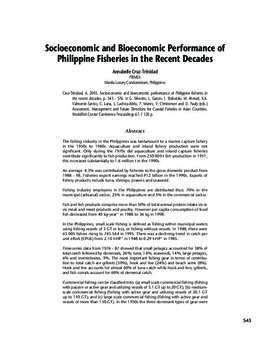Socioeconomic and bioeconomic performance of Philippine fisheries in the recent decades

Citation
Ahmad, A.T.; Tan, Geik-Hong; Yasin, A.H. (2003). Socioeconomic and bioeconomic performance of Philippine fisheries in the recent decades. p. 543-576. Assessment, management and future directions for coastal fisheries in Asian countries. WorldFish Center conference proceedings; 67
The fishing industry in the Philippines was tantamount to a marine capture fishery in the 1950s to 1960s. Aquaculture and inland fishery production were not significant. Only during the 1970s did aquaculture and inland capture fisheries contribute significantly to fish production. From 250 000 t fish production in 1951, this increased substantially to 1.6 million t in the 1990s. An average 4.3% was contributed by fisheries to the gross domestic product from 1988 - 98. Fisheries export earnings reached P12 billion in the 1990s. Exports of fishery products include tuna, shrimps, prawns and seaweed. Fishing industry employees in the Philippines are distributed thus: 70% in the municipal (artisanal) sector, 25% in aquaculture and 5% in the commercial sector. Fish and fish products comprise more than 50% of total animal protein intake vis-à-vis meat and meat products and poultry. However per capita consumption of food fish decreased from 40 kg·year-1 in 1988 to 36 kg in 1998. In the Philippines, small scale fishing is defined as fishing within municipal waters using fishing vessels of 3 GT or less, or fishing without vessels. In 1948, there were 63 005 fishers rising to 743 544 in 1995. There was a declining trend in catch per unit effort (CPUE) from 2.10 t·HP-1 in 1948 to 0.29 t·HP-1 in 1985. Time-series data from 1976 - 87 showed that small pelagics accounted for 38% of total catch followed by demersals, 26%; tuna, 16%; seaweeds, 14%; large pelagics, 6% and invertebrates, 9%. The most important fishing gear in terms of contribution to total catch are gillnets (30%), hook and line (24%) and beach seine (8%). Hook and line accounts for almost 60% of tuna catch while hook and line, gillnets, and fish corrals account for 60% of demersal catch. Commercial fishing can be classified into: (a) small scale commercial fishing (fishing with passive or active gear and utilizing vessels of 3.1 GT up to 20 GT); (b) medium-scale commercial fishing (fishing with active gear and utilizing vessels of 20.1 GT up to 150 GT); and (c) large scale commercial fishing (fishing with active gear and vessels of more than 150 GT). In the 1950s the three dominant types of gear were bag net, the trawl (including beam and otter types) and the round haul seine. The larger tonnage category (more than 100 GT) became more significant in the 1980s. There are 35 species comprising 70 - 95% of total commercial fish production grouped as demersals, small pelagics and large pelagics. Roundscads dominated the small pelagics, followed by slipmouth, a demersal species. Declining catches, disappearance of high value species and increasing volume of juveniles are indications that the fishery is biologically over-fished. This translates as declining profit for the fishery sector. It also means that the fishery employs excess labor and utilizes capital that could be used in other economic sectors.
Permalink
Date Available
Type
Publisher
Countries
Copyright
CC BY 4.0
Research Themes
Topics
Language